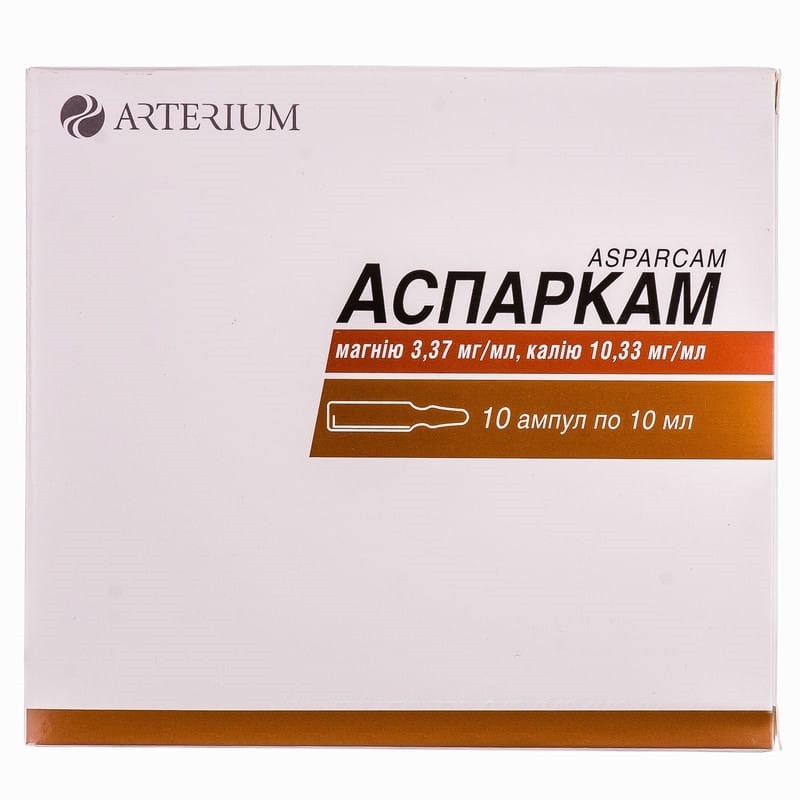



 Secure and encrypted payment processing
Secure and encrypted payment processing We ship to over 40 countries including the USA, UK, Europe, Australia and Japan
We ship to over 40 countries including the USA, UK, Europe, Australia and Japan Guaranteed refund or reship if you haven't received your order
Guaranteed refund or reship if you haven't received your orderAsparkum has antiarrhythmic properties, compensates for the deficiency of magnesium and potassium ions. magnesium activates the sodium-potassium atphase, as a result of which the intracellular sodium content decreases and potassium penetrates into the cell. with a decrease in the concentration of sodium in the cell, sodium-calcium metabolism in the smooth muscles of blood vessels is inhibited, which leads to their relaxation, potassium ions stimulate the synthesis of atph, glycogen, proteins, acetylcholine; potassium and magnesium support the polarization of cell membranes. asparaginate promotes the entry of ions into the cell and is involved in energy metabolism. antiarrhythmic effect is realized due to the ability of the drug to eliminate the imbalance of electrolytes, reduce the excitability and conductivity of the myocardium.
Pharmacokinetics Not investigated.
The drug is intended for intravenous administration only. adults should be intravenously injected dropwise - 10–20 ml (dilute the contents of the ampoule in 50–100 ml of 5% dextrose solution). if necessary, the dose can be re-administered after 4-6 hours. The drug is suitable for combination therapy.
The course of treatment is determined by the doctor.
Children. The experience of using the drug in children is insufficient, therefore it is not used in this category of patients.
With rapid iv administration of the drug, the possibility of symptoms of hyperkalemia, for example, nausea, vomiting, diarrhea, paresthesia, and / or hypermagnesemia, for example, redness of the face, hyporeflexia, convulsions, heat sensation, respiratory depression, should be taken into account.
With prolonged use of the drug, it is necessary to control the level of potassium and magnesium in the blood, and regular monitoring of electrolyte hemostasis and ECG data is also necessary.
Asparcam as a drug containing potassium and magnesium should be used with caution in patients with myasthenia gravis; in conditions that can lead to hyperkalemia, such as acute dehydration, widespread tissue damage, in particular with severe burns. In this category of patients, it is recommended to regularly examine the level of electrolytes in the blood serum.
Since the drug contains sorbitol, patients with hereditary fructose intolerance should not use this drug.
Use during pregnancy and lactation. So far, no danger has been reported with the use of the drug in this category of patients.
The simultaneous use of the drug with potassium-sparing diuretics and / or APF inhibitors increases the risk of hyperkalemia.
Cases of overdose are unknown. in case of an overdose, symptoms of hyperkalemia and hypermagnesemia can be observed.
Symptoms of hyperkalemia: general weakness, paresthesia, bradycardia, paralysis. An extremely high concentration of potassium in blood plasma can lead to death from inhibition of cardiac activity, arrhythmias, or cardiac arrest.
Symptoms of hypermagnesemia: nausea, vomiting, drowsiness, hypotension, bradycardia, weakness, slurred speech, double vision. At very high plasma concentrations of magnesium, hyporeflexia, muscle paralysis, respiratory arrest and cardiac arrest may develop.
In case of overdose, cancel K+-, Mg2+Aspartate and symptomatic treatment is recommended (calcium chloride 100 mg / min iv, dialysis, if necessary).
In the original packaging at a temperature not exceeding 25 ° C. Keep out of the reach of children.